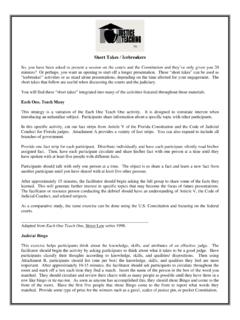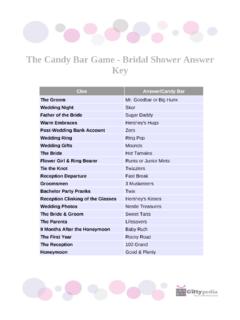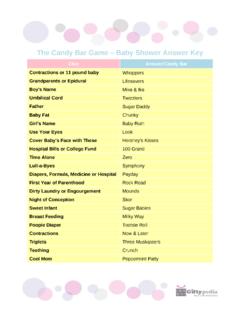Transcription of ACTIVITY - Justice Teaching
1 Grade Level: K-3 Introduction / Objectives:This ACTIVITY will help students understand the need for rules, the rulemaking process, and the role of the student / citizen. Students will be introduced to the relationship between rules and laws and how citizens can establish laws in their communities, much like rules in the classroom, to help them live classroom constitution will provide a foundation for understanding and reinforcing the principles and ideals which provide the framework for American exercise may be most useful at the beginning of the school year to establish a democratic classroom learning environment. Work directly with the teacher as you plan to do this Strategies:Game, Brainstorming, Problem Solving, Reflective ThinkingStandards: Grades K-3: Civics and Government Grade K: Standard 1 , Grade 1: Standard 1 Grade 2: Standard 1 , Standard 3 Grade 3: Standard 1 , Standard 3 Resources Needed: candy or erasers / some other item to use in the game, parchment paper if available, bulletin board Part I: Developing the ACTIVITY / Getting Started Begin by telling the students that you want them to play a new game to help them understand about government and laws.
2 Divide the class into 3 or 4 straight lines and give the first person in line a piece of candy , or another item. Then say, Okay everybody, let s play the candy game. Don t say anything else. The children will probably look confused and ask how to play the game. Follow the directions to help the students see that they need to have rules in order to play the II: Making Connections / Tests for Good Rules After playing the candy Game with clear rules, ob-serve that to play games together children need rules and that to work and live together people also need to have the students why people need rules in families, on playgrounds, on buses, in schools, neighborhoods and communities. List the children s responses and review all to consolidate ideas. Be sure to keep this list ,Rules,RulesRULESC andy Game1. Next, tell the first person in each line to pass the candy from the front to the back of the line.
3 Tell the last person to bring the candy up to the first person in After students begin to play, interrupt the game at intervals to give one of the following directions: Oh, you must pass the candy with your eyes closed. Oh, you must pass the candy with your left hand. Oh, everyone should be on their knees. Oh, you are to come backwards to me when you bring the After each interruption, ask teams to begin Stop to review problems with the Note that they had difficulties because of the way that the rules were given. Lack of agreement about the rules and constant change of direction lead to confusion. Ask students, What is the purpose of having a rule? Who must follow the rules? What happens if a rule is broken? What happens if a rule is not clear? 6. Ask students, How are rules made? Write, A rule should be clear and easy to follow, on the board.
4 Work with the group to develop a clear set of rules for the candy Game. List the students suggestions, then vote to select a few simple rules for the Play the game again to demonstrate that clear rules and directions make for a good experience while playing Let students know that rules for children are a lot like laws for for Good Rules The rule should be easy to follow. The rule should be simply stated. The rule should include only activities we are able to perform. The rule must be reasonable. The rule must not go against another rule. The rule should be fair. The rule should help create a better place to live and learn in students how they can tell if a rule is a good rule. List their responses and tie in to the rules they developed for the candy Game. Post responses and add others listed in Tests for Good Rules box, if not already included.
5 Demonstrate how rules might not pass these tests. Give an example of a good rule and a bad rule. A bad rule example might be Only boys can run in the hall by the rear exit if they are third in line and have lunch boxes. Why is this a bad rule? Be-cause the rule is not fair to everyone and is not simply stated. The rule is also not easy to UpAsk students if they have rules in their families. In their journals or as a homework assignment, ask students to write a sentence and/or draw a picture of one family rule. Have students talk with their parents about family rules. Develop a bulletin board with III: Creating A Classroom Constitution/Rules to live by (Do with teacher s permission and assistance if appropriate)For a class that already has rules (written or unwrit-ten), have the children begin by identifying and have the teacher/recorder write down these rules.
6 Then list any other rules the children believe the class needs. The group will then have two sets of rules Rules We Have and Rules We Need. For a class that has not established any rules, start them off by discussing and listing some potential rules on the chalkboard. Talk over the rules together and write the rules on a chart for all to see. Guide students in testing their rules. See part two students know that laws are a lot like rules. Laws provide rules for life much like school rules provide structure for our classroom. Tell students that they will use their classroom rules to develop a constitu-tion. A constitution is a written plan to help establish and organize the rules we live constitution also organizes how our government works. You can use your classroom constitution to help your classroom run smoothly. For awareness pur-poses, you may post copies of the Constitution (federal government), and the Florida Con-stitution (state govern-ment) on a bulletin board.
7 Title the bulletin board, Rules we live by. Rules arelike laws forlittle people. (Elementary Student)The students should now VOTE to accept or reject rules to include in the classroom constitution. After voting on the classroom rules, develop these into a classroom constitution. For a preamble, consider something like, We the students in Mrs. Wesson s kindergarten . Then incorporate the rules you have agreed upon. Post prominently on large chart paper and have each child and teacher sign the Class-room Constitution. Students should understand that their signatures represent a commitment to obey the rules set forth in the constitution. If possible, give each student a small classroom constitution on parch-ment paper to take home and discuss with their your Classroom Constitution on your bulletin board once it is finalized. Refer to it often and con-sider changes as needed.
8 Decide how the Constitution can be revised ( majority vote of class?).Part IV: The Relationship Between Rules and Laws Discuss with students that laws are a lot like rules and that citizens have a part in making laws just like they had a part in making the classroom rules. Laws will help us live together and help keep us safe. They can also help make sure we are treated students if they know any laws. List some on the board such as seatbelts, stop signs, and speed we have so many people in our communi-ties, it is sometimes necessary to elect a few people to develop our community rules/laws for us. We vote for these people to help us make the rules/laws to live together in peace and the school level, we vote for student government/council members. Locally, we elect city and/or county commissioners and school board members to help with local rules and decisions.
9 At the state level, we elect representatives and senators to make our state laws in Tallahassee. Federal laws are made in Washington, by Reresentatives and students to write or draw in their journals about what life would be like without rules and laws (chaos, confusion, ). You may want to ask if students have seen the show Kid V: Solving a Community Issue(The Citizen s Role) In this concluding ACTIVITY , students will assist in developing rules for their community. Tell students that they will need to develop rules for a pretend park. What rules will be needed to keep the park safe, clean, and fun for the children in the community? Ask each child to draw the park and write/draw one rule for the park. Have each student read the rule they developed and show their with praise about what good citizens the students have been and that all citizens have a respon-sibility to help develop and test rules.
10 It is also the responsibility of citizens to follow the in part from sources:Rules, Rules, Rules developed by David T. Taylor, et al, the Ohio Bar Association, 1980; Sure Fire Presentations, American Bar Association Special Committee on Youth Education for Citizen-ship, 1993; and from Elementary Law Related Education Source Guide, grades 3-6, Cleveland Public Schools, Eraser Game (Adapted from The Buckle Game designed by Harriett Bickleman Joseph)Creating a Classroom Constitution Learning Experience for Elementary Law Related Education Beverly Dulaney, Joyce DeMasi, Jacquelyn Lendsey, Laura Ellen Stein. May 1980 Social Education Without Rules ActivityNote: In this supplemental ACTIVITY , use after the follow up ACTIVITY on page two. Have students read the following scenario and/or read it to the class. Then put the students together in groups of three to finish the story.











